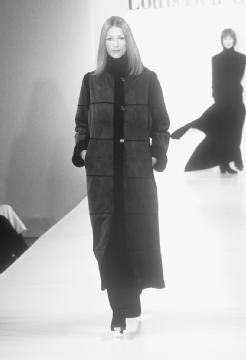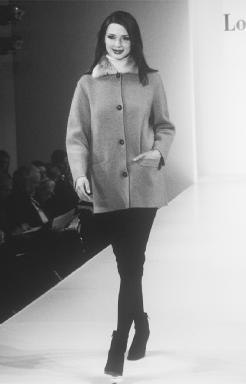Louis Dell'olio - Fashion Designer Encyclopedia
American fashion designer
Born: New York, 23 July 1948. Education: Graduated from Parsons School of Design, 1969. Career: Intern for Norman Norell, 1965; assistant at Teal Traina, 1969-71; designer for Originala's Giorgini

Publications
On DELL'OLIO:
Books
Stegemeyer, Anne, Who's Who in Fashion, Third Edition, New York, 1996.

Articles
Dougherty, Margot, "Making Anne Klein Click," in Life, November 1982.
Conant, Jennet, "The Man Behind Anne Klein," in Newsweek, 3November 1986.
Gross, Michael, "Louis Who?" in New York, 17 October 1988.
Morris, Bernadine, "The Dell'Olio Formula: Start with the Classic, Then Add Aggression," in the New York Times, 15 November 1988.
——, "From Louis Dell'Olio, Clean Cuts and Colors," in the New York Times, 14 April 1989.
Capitain, Jenny, "Louis the First," in Vogue, February 1990.
Staples, Kate, "Louis Dell'Olio: Back in Form," in WWD, 26 June 1991.
Morris Bernadine, "Dell'Olio's Soft Spin Enlivens Sportswear," in the New York Times, 6 November 1992.
Rourke, Mary, "Made for the U.S.A. Designer," in the Los Angeles Times, 22 February 1993.
White, Constance C.R., "Easy Transition is Top Properity at Anne Klein," in WWD, 5 May 1993.
Ozzard, Janet, "Accento Americano," in WWD, 9 August 1995.
——, "Dell'Olio's New Gig," in WWD, 10 July 1996.
Daria, Irene, "Dell'Olio: The Rush to Be Creative," in WWD, 5January 1997.
Wilson, Eric, "Dell'Olio Unwraps Outerwear," in WWD, 9 April 1997.
Ozzard, Janet, "Dell'Olio Fashions Collections for QVC," in WWD, 2May 2000.
***
Louis Dell'Olio is acknowledged as one of the leading American women's sportswear designers, creating wearable and commercial pieces that feature the classic lines typical of sportswear yet manage innovative twists to set them apart. Dell'Olio has achieved the rare distinction of being loved by critics and consumers alike.
Dell'Olio made his name first as codesigner (with Donna Karan) and then as lead designer at Anne Klein, the label launched by the legendary American sportswear designer. After Klein's death in 1974, Karan, who had been her assistant, asked longtime friend Dell'Olio—who had attended Parsons School of Design with her—to become her codesigner at Klein. The partners were just a few years out of Parsons when they took over the firm. Their first collections were not highly regarded; they designed initially by trying to emulate what they imagined Klein would do.
After a few years, the two designers broke away from traditional Klein wares and began to come into their own, designing a series of critically acclaimed collections. Consumers embraced the brand, and sales grew robustly. When Karan left in 1986 to launch her own label, Dell'Olio took over as the sole designer for Anne Klein. Although retailers and the fashion press wondered if the quiet designer would be able to maintain the company's high reputation and sales, their fears were put to rest after the first few collections. Critics proclaimed Dell'Olio's work became stronger over time, and customers must have agreed, because he ultimately took his place as the bestselling American designer. Anne Klein under Dell'Olio grew to a $200-million wholesale brand in sportswear alone, enhanced by another $250 million in sales of licensed products.
As the president of Bergdorf Goodman told the New York Times (15 November 1988), "[Dell'Olio] understands the needs of women in all walks of life. He makes clothes that are fashionably up to date but that a woman can feel she will be able to wear the next year. And his business is growing." Retailers have always appreciated Dell'Olio's penchant for listening to their needs. His interest extends to the business side of fashion as much as to the creative side.
Bernardine Morris, writing in the New York Times (6 November 1992), noted Dell'Olio's ability to create familiar and comfortable apparel, yet at the same time use innovative designs. "Serene and comforting as the show was to watch," she said of his spring 1993 collection (one of his last for Anne Klein), "the clothes still looked different from what women already have in their wardrobes. But they didn't look fussy or overdesigned. Just soft, basic shapes that could be combined in different ways, the basic premise of sportswear dressing."
Dell'Olio's designs are purposely American in sensibility; he is known for taking European designs and Americanizing them. Many of his collections have a certain masculine quality—such as boxy shoulders on his blazers, always a core item in his sportswear lines— and he has favored apparel that is flattering and make women feel sexy yet fully dressed. These clothes are targeted at upscale working women, with celebrities ranging from Oprah Winfrey to Cher (in her more serious moments). In addition to blazers, other core items include narrow pants, turtleneck sweaters, and wraparound skirts in black, ivory, and neutrals, set off by the occasional burst of color (such as an all-red series that stood out in one of his collections).
Dell'Olio left Anne Klein in 1993 to pursue his own collections, replaced by Richard Tyler, who the company hoped would take the brand into younger, more exciting directions. Dell'Olio had, some criticized, started to have an element of sameness in his clothes each season. Retailers were taken by surprise at the transition, which both Anne Klein executives and Dell'Olio stressed was his decision. Unfortunately for Klein, the departure of Dell'Olio marked a downward slide for the retailer, and Tyler was soon ousted. Dell'Olio, however, began to forge alliances with a range of companies through consulting and licensing agreements. He became a consultant for Italian sportswear manufacturer Marzotto, helping it hone its bridge line, Accento, especially for the U.S. market. He launched a collection called Dei Tre exclusively for Bergdorf Goodman, Neiman Marcus, and the Canadian chain Holt Renfrew, which he designed with the input of the retailers.
Dell'Olio also started to expand into categories outside sportswear. He created a licensed line of outerwear for the Tepper Collection (the contract transferred to Androu when Tepper shut down), in which he took sportswear looks and translated them into moderate-priced stadium jackets, bathrobe coats, and other items under the Louis Dell'Olio Luxe and LDO Studio labels. He also expanded into furs and shearlings with Legar. In 2000, Dell'Olio began an alliance with the television shopping network QVC for an exclusive line of moderate separates and dresses under the Linea by Louis Dell'Olio label. The partners planned four collections a year, with Dell'Olio appearing on QVC to help promote the line.
All of Dell'Olio's new ventures remained true to his desire to create wearable, consumer-friendly women's clothes, although they tended to show more of a focus on color than his previous work. His reputation for quality craftsmanship and good fit, built during his 18 years at Anne Klein, remains strong.
—KarenRaugust
Comment about this article, ask questions, or add new information about this topic: